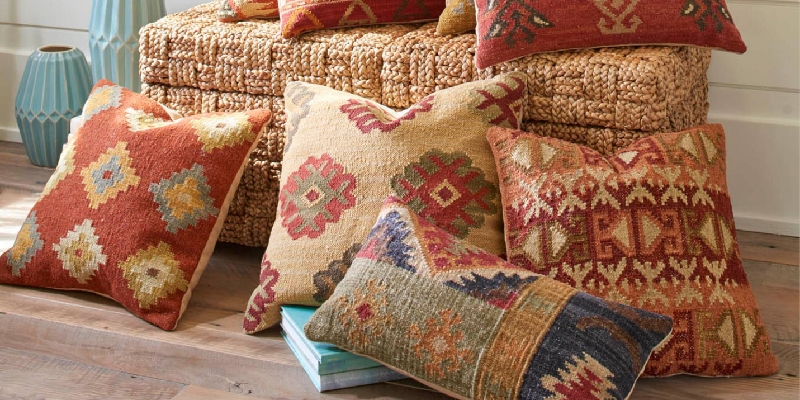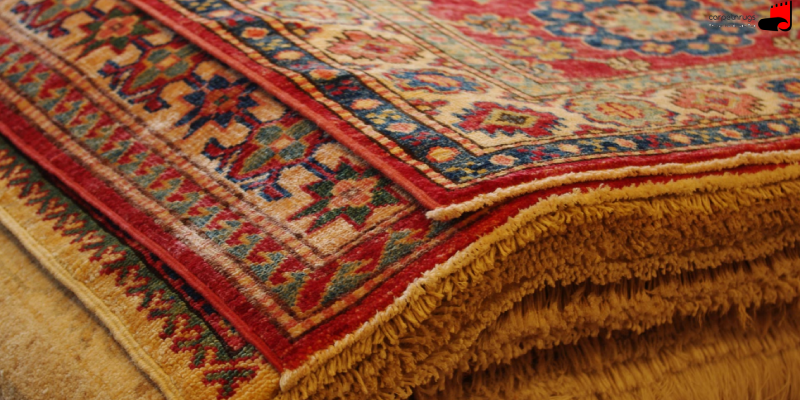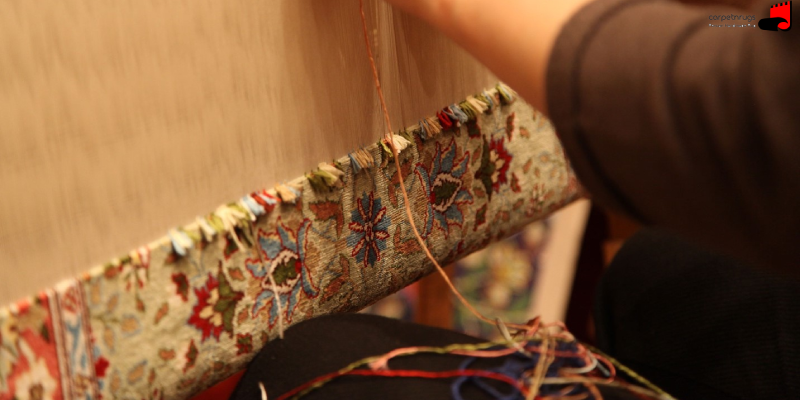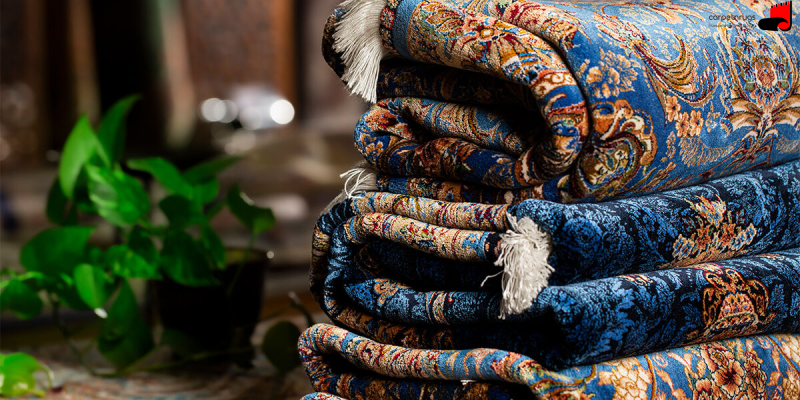Getting to know the differences between carpets and rugs

Carpets and rugs are both authentic Iranian arts. These two textures are very similar at first glance. But when we examine its other specifications such as structure and price, we will see many differences. Glim is a word of Turkish origin that refers to a pile-free carpet with multiple uses. In order to weave the rug, they use several flat weaving techniques. In addition to Iran, this art can also be found in other regions such as Turkey, the Balkans, the Caucasus, Afghanistan, Pakistan, and Central Asia. The most important feature of a carpet compared to a rug is its pile. The carpets are thicker and have a different texture. The differences between carpets and rugs can be examined from various aspects, which we will discuss below.
Carpets and rugs are both valuable art products that have many fans. But not everyone may know the difference between the two. In the context of each of these, different principles are followed and different raw materials are used. Due to the fact that carpets are older than carpets, they use traditional raw materials such as wool and cotton in its texture. On the other hand, in addition to wool and cotton, fibers such as silk and fluff are also used for carpet weaving. With the advent of carpet weaving machines, artificial fibers are also considered a widely used material in carpet weaving. Of course, raw materials are only one of the differences between carpets and rugs. We will examine other distinctions of these popular and original art products below.

The difference between carpet and rug in terms of application
As mentioned before, unlike carpets, carpets do not have any piles. We can easily recognize this difference by looking. In carpet weaving, the piles are wrapped around the threads and the weft is placed on it. But in carpet weaving, only the weft is passed between the threads and there is no pile. This has caused the applications of rugs and carpets to be different. The functional differences between the two are:
- The design of the carpet is limited and its patterns are simple and abstract. While in the texture of the carpet, any complex and detailed design can be implemented.
- Because of the simpler designs and patterns, they tend to use carpets in modern decorations.
- On the other hand, carpets give a beautiful look to the space due to their eye-catching designs and are more noticed. The vivid color palette is another attractive feature of the rug.
- The carpet can be used as a floor covering, wall hanging, table cloth, furniture cover, bedspread and cushion cover. The multitude of carpet designs and colors make it suitable for any style of furniture, whether Scandinavian, classic, modern or rustic.
- Due to the high variety of fibers, price, quality and patterns, carpets are used for industrial and commercial institutions, stores, hotels, etc. in addition to private homes.
- Due to the technique and high speed of carpet weaving, this product is less soft and durable than carpet. For this reason, today it is not used much for everyday use and floor covering, and its decorative aspect is more prominent.
The difference between carpet and rug in terms of dimensions and size
Since the rug has no fluff, it is flat. Accordingly, these are much more simply woven and lighter than carpets. They often use horizontal dar in carpet weaving and vertical dar in carpet weaving. In general, rugs are offered in smaller sizes. Machine-made carpets are available in standard sizes of 6, 9 and 12 meters. These carpets are also produced in shapes such as square and circle. It is worth noting, some non-standard dimensions can be customized for machine-made carpets. The dimensions of the rug are more descriptive. Different carpet formats include:
1- A small rug used as a janmazi
This rug is woven in a width of 60-65 and a length of 90-100 and is mostly used as a janmazi or rug. In some areas, it may also be used as a baby floor.
2- Rug is a delicately woven product
The rug is woven in a width of 100-110 and a length of 160-170 with a finer texture than other larger rugs. The texture of this rug is not common among the nomads anymore.
3- A suitable underlaying rug
This rug is woven with dimensions of 150 x 250 and can be used as a carpet and underlay.
4- The most widely used large rug among the nomads
Wide applications of this product with dimensions of 170 x 280, such as underlay, cover for provisions, covering the load of horses and camels, etc.
5- A rare hand-woven long carpet
This type of carpet with a length of 4 meters and a width of about 2 meters has a unique application among the nomads and is very rare.

The difference between carpet and rug in terms of price
Have you noticed the price difference between the two when you went to the stores to buy carpets and rugs? Definitely, the higher price of a product indicates its higher quality and value. But considering the similarities of carpets and rugs, why do they have different prices?
1. Using more raw materials in the production of carpets
As expected, they often use more fibers and raw materials to create the rug’s precise piles and patterns. The difference in the amount of raw materials in the production of carpets and rugs is very significant and impressive. For example, we need 8 kg of wool to weave one square meter of carpet. However, only about 1 kg of wool is enough to weave the same dimensions of the rug.
2. Lower speed and higher accuracy of carpet weaving
The carpet must be woven exactly according to the plan, but the design of the rug depends on the taste of the weaver and most of the time it does not have a plan. These items increase the speed of running the rug compared to the texture of the hand-woven carpet . A carpet weaver must first know how to read a map, then create designs according to the map. This work is very time-consuming and requires high precision.
3. More value of carpets than rugs
Considering the mentioned factors, it can be easily concluded that the carpet has more value compared to the rug. In this way, you have to pay more to buy a carpet. Of course, don’t forget that machine-made carpets are much cheaper and more economical than hand-woven ones.
5 ways to clean a white carpet
White carpets are beautiful and add a lot of character to any room they are placed in. However, the smallest stain on a white carpet quickly becomes noticeable and spoils the whole effect of the room. If you want your white carpet to always be in its best condition, you need to know how to clean it. The best methods for cleaning white carpets are:
1. Amazing effect of white vinegar
Vinegar is one of the best carpet cleaners for water-soluble stains. If the carpet stain is caused by spilled milk, soda, jelly, fruit, paint, alcoholic beverages, and pet waste, vinegar is a great choice.

How to use vinegar:
• Dissolve a quarter of a teaspoon of white vinegar in 0.95 liters of water.
• Mix the liquid well and pour it into an empty spray bottle.
• Spray the resulting liquid on the dried spot.
• Clean the spot with a sponge and then dry it with a paper towel. Thoroughly remove moisture from the cleaned area.
In this recipe, instead of vinegar, you can use non-bleaching detergent or clear dishwashing liquid.
2. Remove specific stains with ammonia solution
Some stains such as chocolate stains, vomit, blood, wine, coffee, tea and mustard cannot be removed with white vinegar solution. For this purpose, mix a tablespoon of ammonia with a cup of water and pour it into a spray bottle. Then spray it on the stain. For better effectiveness, quickly wipe the stain with a clean tissue.
3. Iron solution for greasy stains
To remove oil or wax stains from a white carpet, place a paper towel over the stain and iron it. Finally, use water and dishwashing liquid.
4. Sieve cotton is the enemy of stains caused by glue
You can remove glue stains from your white carpet by placing a cotton swab dipped in alcohol.
5. Removing gum stains with ice
Is wax or gum stuck to your beautiful white carpet? Place an ice pack on the stain for 20 minutes and restore the beauty of your carpet.


